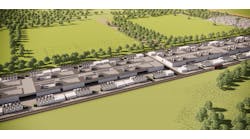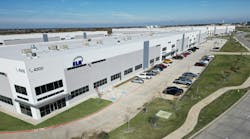Credit: Michael Stern via Wikimedia Commons
Building efficiency led the 8 percent growth in global advanced energy in 2015, according to a new report from the Advanced Energy Economy.
“The U.S. advanced energy market hit $200 billion, nearly double the nation’s beer market, larger than pharmaceutical manufacturing, and closing in on wholesale consumer electronics,” said AEE in releasing the report last week.
“One of the things we want to tell the world is a lot of these better energy solutions are here today in the marketplace; people and companies and utilities are investing in them now and they are growing,” said Bob Keough, spokesman for AEE. “Increasingly, they are competing on their own in terms of price and value.”
While building efficiency may elicit yawns for some, there’s lot to be excited about in this sector. It was the largest single segment of advanced energy technology in the US by revenue, yielding $63.6 billion, he said.The report, conducted by Navigant Research, defines advanced energy technologies as high efficiency, advanced technologies, Keough noted.
“Building efficiency has been one of the most consistent drivers of revenue over the last five years, up steadily year after year, and up 50 percent overall between 2011 and 2015,” he said.
New technologies and higher investments in them drove the growth. More net zero energy buildings are being constructed, and installation of new lighting systems is growing.
While CFLs have been the lighting systems that yielded the biggest revenues in the past, LEDs and lighting controls are now big income generators, Keough noted.
Meanwhile, energy storage revenues increased more than 1,000 percent in one year — from $58 million in 2014 to $724 million in 2015. “It’s a market segment that’s really taking off,” said Keough.
While California’s energy storage mandates are driving much of the growth, other parts of the country are also seeing investments in energy storage.
“Some of the utilities in California are buying more energy storage than they’re mandated to because they’re finding it’s so cost effective,” said Keough. “It’s starting to take hold everywhere. PJM in its control center has installed a battery system from AES that they claim saves $20 million a year.”
Frequency Reg Market Drives Storage
One of the drivers of the growth in energy storage is utilities’ need for frequency regulation.
“That’s often the area where utility-scale storage is going first because it’s a fast-response technology and very valuable as an ancillary service,” said Keough. “Some California utilities are seeing energy storage as eventually being a peaking resource, as well as managing the variability of renewable energy.”
One of the AEE companies, Stem, is growing a market in which large energy users with high peak demand charges use battery storage to store energy when it’s inexpensive to use during periods of peak demand, which brings down their demand charges, Keough said.
In terms of job creation, energy efficiency leads the pack, said Keough. And so does California.
“There’s a lot happening in energy efficiency and we’re seeing new jobs created and transformation of existing jobs,” he said. “The number of people involved in installing HVAC equipment who are now installing high-efficiency equipment has grown. AEE has only quantified job growth in California to date, and found that there were more than 400,000 advanced energy jobs in the state in 2014. “We expect to verify that the number has grown to over half million jobs in 2015,” he said. “‘The vast majority are energy efficiency jobs. There’s no substitute for people installing equipment and materials.”
The advanced energy industry generated jobs at a 5 percent rate in California from 2013 to 2014, which was more than double the rate of overall state job growth — which was 2.2 percent –and about three times faster than the national job growth rate of 1.6 percent, according to a separate report from AEE, “California Advanced Energy Employment Survey.” Building efficiency and advanced electricity generation represent more than 90 percent of this employment, the report said.
The latest AEE report not only demonstrates that advanced energy technologies — especially building efficiency technologies — are being embraced by utilities, companies and businesses alike. They’re also an important contributor to the economy and environment — and that’s nothing to yawn about.
Read the AEE report here.
Track news about building efficiency and energy storage by subscribing to the Energy Efficiency Markets newsletter. It’s free.








